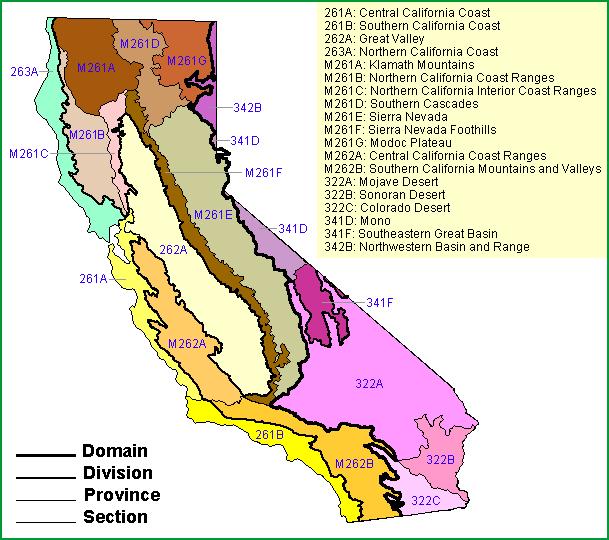 | Southern Cascades |
|
|
http://www.fs.fed.us/r5/projects/ecoregions/m261d.htm
Section M261D
Southern Cascades
This section comprises the southern Cascade Ranges. The crest of the mountain chain is aligned toward the north-northwest between the Sierra Nevada and Mt. Shasta and toward the north from Mt. Shasta northward. MLRAs 5, 21, and 22.
Geomorphology. Volcanic mountains variously eroded; no distinct range. Cascade Ranges geomorphic province.
Lithology. Cenozoic volcanic rocks.
Soil Taxa. Alfisols, Andisols, Aridisols, Entisols, Inceptisols, Mollisols, Ultisols and Vertisols in combination with mesic, frigid and cryic soil temperature regimes and xeric, aridic and aquic soil moisture regimes.
Vegetation. Predominant potential natural communities include the Ponderosa pine series, Big sagebrush series, Idaho fescue series, Western juniper series, Mixed conifer series, white fir series, red fir series and Lodgepole pine series.
The following series are found throughout the section and are not restricted to or extensive in any subsection. Series dominated by exotic plants are not placed in subsections unless they are extensive and stable.
Series dominated by exotic plants: Broom series, California annual grassland series, Cheatgrass series, Introduced perennial grassland series, Kentucky bluegrass series, Tamarisk series.
Series that can occur in all subsections, but are not extensive: Aspen series, Bulrush series, Bulrush - cattail series, Bur-reed series, Common reed series, Cattail series, Creeping ryegrass series, Ditch-grass series, Duckweed series, Holodiscus series, Mosquito fern series, One-sided bluegrass series, Pondweeds with floating leaves series, Pondweeds with submerged leaves series, Quillwort series, Saltgrass series, Sedge series, Spikerush series, Tufted hairgrass series, Yellow pond-lily series.
Series restricted to riparian settings: Arroyo willow series, Black cottonwood series, Black willow series, Mixed willow series, Montane wetland shrub habitat, Mountain alder series, Narrowleaf willow series, Pacific willow series, Red willow series, Water birch series.
Fauna. Mammals include black-tail and mule deer, mountain lion, coyote, bobcat, yellow-bellied marmot, marten, fisher, Sierra Nevada red fox, wolverine and porcupine. Birds include eagles, hawks, owls, woodpeckers, falcons, osprey, quail, northern goshawk and blue grouse. Species of concern include the California and northern spotted owl.
Elevation. 2,000 to 14,000 feet.
Precipitation. 8 to 80 inches.
Temperature. 30░ to 58░F.
Growing Season. 25 to 175 days
Surface Water Characteristics. Common slow and moderately rapid rivers and streams. Rivers flow in alluvial or weak bedrock channels westerly to the Klamath and Sacramento Rivers, and easterly to basins in the Modoc Plateau section.
Disturbance Regimes.
Fire: At lower and mid-elevations, historic occurrence has changed from frequent, low intensity, surface fires to infrequent, high intensity, stand replacing fires. At higher elevations, historic occurrence has changed from infrequent, low and moderate intensity surface fires to infrequent, low, moderate and high intensity surface or stand replacing fires.
Climate: Wide fluctuations in precipitation and temperature for periods of years result in significant or catastrophic changes in biological communities.
Volcanic Activity: Contains locations with eruptive activity (lava flows and ash fall) within the past 200 years.
Land Use. Composition and successional sequence of some communities has changed because of plant and animal species introduced between the mid 1800Æs and early 1900Æs related to mining, grazing, forestry and recreational activities. Expanding foothill communities are scattered throughout the section.
Cultural Ecology. Humans have been utilizing the Cascades for about 8,000 years, and have been an integral part of its ecology for 2,000 to 3,000 years. The 14,000 foot volcano of Mt. Shasta dominates much of the landscape, and is a traditional cultural property of vital significance to five Native American groups, and of symbolic importance to Euroamericans as well. The timber industry played an important role historically; railroad logging systems spread throughout timbered areas. Contemporary attitudes and beliefs tend to be dominated by commodity oriented long-time resident values and a rural lifestyle. The economy is dominated by government employment, but the timber industry, recreation, and ranching are also important.
Subsections. The Southern Cascades section is divided into 13 subsections
Map
Old Cascades- Shasta Valley-Upper Shasta Valley
Blacks Mountain - Susanville Peak-Butte Valley-High Cascades
McCloud Flat-Medicine Lake Lava Flows-Medicine Lake Highlands-Hat Creek Rim
Parker Mountain Flat-Shingletown - Paradise-Lassen - Almanor

